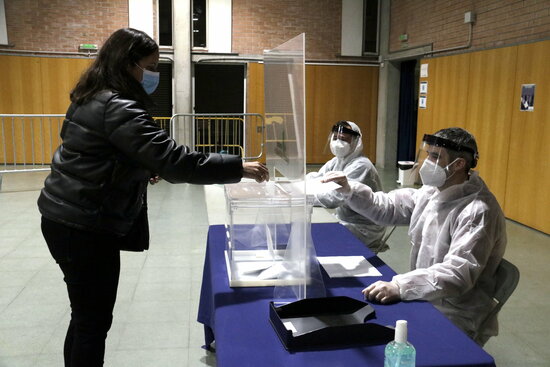Who will win, what turnout, when results will be known: Covid-19 sure to impact election
Vote will take place, but logistics in question as campaign progresses with candidates struggling to confirm potential government coalitions

The election mood in Catalonia is dramatically different ahead of February 14 compared to the last Catalan parliamentary vote, held on December 21, 2017.
Three years ago, right after the peak of the independence push, almost 80% of citizens flooded polling stations in order to assess the role of parties during the referendum.
Now the political conflict is somehow stuck, and on top of that it seems that voters are much more concerned about their safety due to the pandemic than about casting their ballot.
Possibly lowest turnout in a decade
Turnout is expected to fall from 80% to 60%, according to all recent polls, so abstention could reach levels as high as the 2006 or 2010 votes, before the independence push began in 2012.
The lowest turnout was registered in 1995, with only 54.87% of Catalans turning up.
Voters have been bearing tight restrictions in their social and everyday life for almost a year in an effort from authorities to restrain the impact of Covid-19 – and some can barely believe that now 5.6 million citizens are called to attend polling stations in a single day.
Indeed, not even the government wanted to hold the election on February 14, but their attempt to delay it until May 30 was revoked by the Catalan high court.
The fact that most political rallies do not accept audience due to the pandemic also contributes to a possible demobilization.
Another signal of a possible low turnout is the drastic drop of applications of those living abroad; 60% fewer people than in 2017 have requested to vote.
This comes despite a surge in in-mail voting for those residing in Catalonia, with an all-time high of 284,706 requests – but this is understood to be due to the public's concerns of attending polling stations and not an exceptional enthusiasm for the vote.
A very uncertain three-horse race
How the surely low turnout will impact the election remains unknown. Traditionally, right-wing parties have benefited from high abstention, but the reasons of a possible low turnout now are like no other in the past.
So far, polls are undecided on who will prevail; there is a fierce battle for the top spot, with pro-independence Esquerra and the Socialists (PSC) given the first position and Junts per Catalunya, now leading the government, just behind.
What is fairly clear is that the bloc of parties for a Catalan state will prevail again, although by a slim margin and maybe without amassing over 50% of the ballots, this possible outcome is being looked into as it has never occurred before.
Campaign: parties reluctant to talk about coalitions
Half of the two-week election campaign is already gone, with parties holding mostly online events and using some of their efforts to request the people's support in order to avoid "the others" being in power.
Some have already vetoed possible alliances; for instance, ERC, JxCat and CUP have already ruled out sharing an executive with the Socialists.
At the same time, PSC has already said that their preferred government is an adaptation of the one in Spain: with them leading and the Catalan allies of Podemos, Catalunya en Comú (CatECP) as junior partner.
While CatECP would like a cabinet with Socialists and Esquerra, the latter would like one with all those supporting an independence referendum, including CatECP.
In the unionist bloc, Ciudadanos wants a unitary front in the event they can avoid a pro-independence majority, but the People's Party, the Socialists and Vox are reluctant.
Vote logistics and when results will be out
It is customary that the vote takes place in all polling stations as planned, and that a very significant amount of ballots are counted at around 10pm, within two hours after the vote is over.
Yet, neither of these two facts, which are usually taken for granted, are clear for Sunday.
Across Catalonia, over 21,000 people have requested opting out after being randomly picked as election workers, around a quarter of the total number of required individuals to run the vote.
This figure is by far the highest ever and it is largely due to Covid-19 fears, this is despite the fact that the safety measures including PPE for election workers have been enhanced.
The government says that 99% of polling places have, so far, enough staff to run. Although there are alternatives mechanisms to ensure people can cast their ballot otherwise. In a worst case scenario, the vote would have to be postponed until Tuesday in the polling stations that failed to launch on Sunday.
The government has already warned that in the unlikely event that a very significant number of polling stations cannot open because those picked fail to turn up en masse, the results of the counting could be not revealed until Tuesday. This would be without precedent, just like the circumstances in which the vote will take place on February 14.